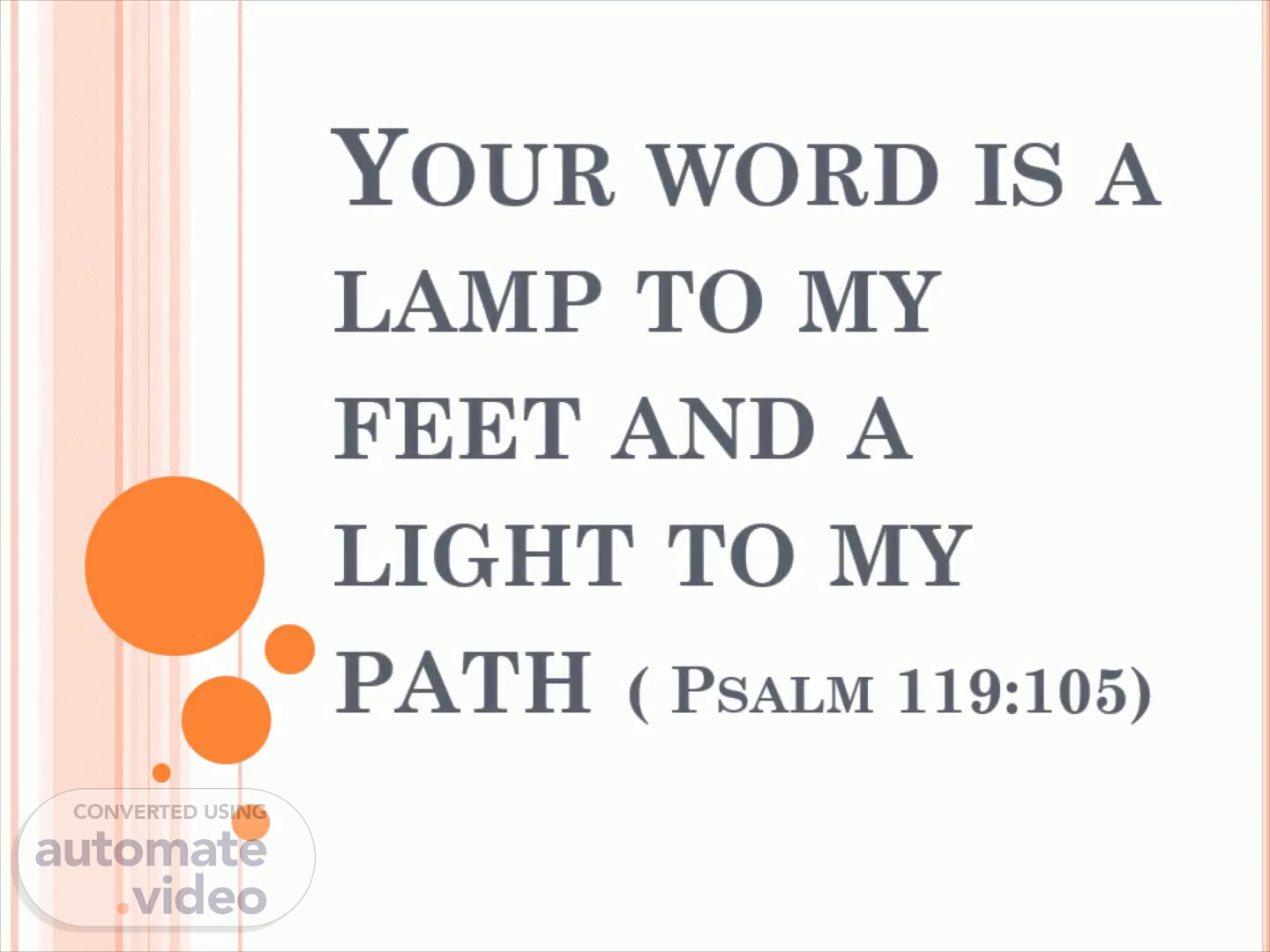
Your word is a lamp to my feet and a light to my path ( Psalm 119:105)
Scene 1 (0s)
Your word is a lamp to my feet and a light to my path ( Psalm 119:105).
Scene 2 (8s)
Gospel According to Mark Series — Bethany Gospel Chapel.
Scene 3 (15s)
ONE Gospel OR 4 Gospels?. Though we speak of four Gospels, in reality there is only ONE “Gospel –.
Scene 4 (29s)
“gospel” (in Greek euangelion; evangelium = Latin) literally means “good news”..
Scene 5 (42s)
Announcement of the good news of the victory in a battle;.
Scene 6 (58s)
Religious. Sense = Saving action of God. Is 52:7 = provides background for NT.
Scene 7 (1m 10s)
Is 52:7 How beautiful upon the mountains are the feet of him who brings good news, who publishes peace, who brings good news of happiness, who publishes salvation, who says to Zion, "Your God reigns.".
Scene 8 (1m 25s)
The term evangelion is used 76 times in the NT (60 are in Paul)..
Scene 9 (1m 38s)
It is this one Gospel that lies behind the four Gospels written by the four Evangelists..
Scene 10 (1m 52s)
The Greek NT Title has as “The Gospel according to Matthew” - Kata Matthaion,.
Scene 11 (2m 6s)
Always used in singular “Gospel”. = One Gospel = Gospel of JC..
Scene 12 (2m 20s)
GOSPELS ARE NOT BIOGRAPHIES OF JESUS. The primary intention of a biographer:.
Scene 13 (2m 35s)
Biography of Gandhi.
Scene 14 (2m 41s)
RARE Signed NELSON MANDELA Biography Long Walk to Freedom 1st Print/1st Edition | #496601324.
Scene 15 (2m 49s)
The Gospels of Mark and John tell us nothing about Jesus' birth, childhood and early life..
Scene 16 (3m 5s)
John never mentions the NAME of the mother of Jesus (Mary);.
Scene 17 (3m 19s)
How did Jesus look like?. Tall, handsome, with mass of flowing hair…. (from movies…).
Scene 18 (3m 37s)
Jesus of Nazareth Full Movie HD English - YouTube.
Scene 19 (3m 44s)
Jesus Of Nazareth | Sky.com.
Scene 20 (3m 50s)
Jesus did not write anything. His words were passed along orally for decades.
Scene 21 (4m 7s)
Please NOTE:. NO Gospel gives us a complete and IMPARTIAL account of Jesus’ life..
Scene 22 (4m 21s)
Gospels: They are documents of faith, written by believers for believers..
Scene 23 (4m 32s)
The Gospels themselves make no claim as to their authorship..
Scene 24 (4m 48s)
Irenaeus (ca.180 AD), added his belief that Luke, the follower of Paul, put down in a book the gospel preached by that apostle..
Scene 25 (5m 3s)
Opinion of modem scholars= Mark's is the earliest Gospel.
Scene 26 (5m 18s)
Each of the Gospels was written at a different time;.
Scene 27 (5m 31s)
However, the first three Gospels, namely, Matthew, Mark and Luke, share a basic narrative core and include considerable common material, and therefore they are known as "Synoptic Gospels"..
Scene 28 (5m 45s)
The Gospels are intended to be an account of what “Jesus did and taught” (cf. Acts 1:1; Mt 4:23). But none of the Evangelists took down in shorthand what Jesus said;.
Scene 29 (6m 2s)
We know that Luke was not an eyewitness of Jesus’ ministry;.
Scene 30 (6m 16s)
THE THREE STAGES IN THE FORMATION OF THE GOSPEL TRADITION:.
Scene 31 (6m 35s)
Historical Jesus – Born in Bethlehem. (Legal) Parents: Mary and Joseph.
Scene 32 (6m 50s)
Jesus chose companions who travelled with him and saw and heard what he said and did..
Scene 33 (7m 6s)
The first stage is also called the stage of the “ipsissima verba Jesu” (the very words of Jesus),.
Scene 34 (7m 22s)
How could one say that what we have in the Gospels are the ipsissima verba Jesu?.
Scene 35 (7m 38s)
However, we DO have some Aramaic expressions preserved in the Gospels, for example, “Abba” (Mk 14:36), “Talitha cumi” (“Little girl, arise”, Mk 5:41), “Ephphata” (:be opened”, Mk 7:34), “Eloi, Eloi, lama sabach-thanii” (“My God, my God, why hast thou forsaken me”, Mk 15:34)..
Scene 36 (7m 57s)
It is to be remembered here that, though the Evangelists do not hand down to us the ipsissima verba Jesu, yet they preserve the essential message of Jesus..
Scene 37 (8m 9s)
The Second Stage is that of the Preaching of the Apostles (30-66 AD) (Stage of the Oral Tradition).
Scene 38 (8m 27s)
This change of language involved translation in the broadest sense of that term..
Scene 39 (8m 42s)
Some of the differences in the Synoptic tradition are due to this sort of accommodation..
Scene 40 (8m 58s)
3) The Third Stage; The Written Gospels (67-100 AD).
Scene 41 (9m 14s)
The recognition that the evangelists were not eyewitnesses of Jesus’ ministry is important for understanding the differences among the Gospels..
Scene 42 (9m 24s)
The central focus of all the four Gospels is the one and same Jesus..
Scene 43 (9m 42s)
They present a common picture of Jesus who begins his ministry of teaching and healing in Galilee;.
Scene 44 (10m 0s)
Same sequence;. vocabulary,. Style. theology;. they form a special group and are called "Synoptic Gospels"..
Scene 45 (10m 12s)
The term “synoptic” is an adjective;. from the noun “synopsis”.
Scene 46 (10m 27s)
The term “synoptic” goes back to a German biblical scholar J. J. Griesbach..
Scene 47 (10m 43s)
There are striking agreements between three Gospels (as mentioned): sequence of events narrated; in language and style..
Scene 48 (11m 0s)
Is this similarity due to the literary relationship of the first three Gospels to one another?.
Scene 49 (11m 18s)
They do not simply record events in chronological order;.
Scene 50 (11m 33s)
Now the question is:. How can we explain the striking agreements between the first three Gospels, and how can we explain the differences that exist in spite of the extensive agreements?.